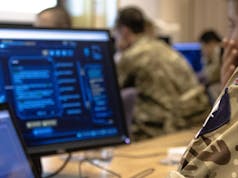Computer and information technology advancements have propelled C5ISR to the top of the US defence electronics market say analysts.
Forecast International projects that this market will be worth at least $171.2 billion from 2020-2029.
“The defense electronics market in the United States continues to focus on enhancing, modernizing, and upgrading existing systems while at the same time developing new technologies,” said Richard Sterk, Senior Analyst and editor of Forecast International’s yearly analysis ‘The Market for U.S. Defense Electronics’.
Sterk further said:
“Integrating multimission systems and applications through networking into real-time operations remains a priority of the C5ISR – command, control, communications, computers, combat systems, and intelligence, surveillance and reconnaissance – industry. Examples of technology that achieve this end include network battle command and logistics systems, networked precision missiles and gun-launched munitions, improved intelligence sensors, and active and passive protection systems. These technologies, in turn, have created additional submarkets such as cyber warfare, cybersecurity, and surveillance/reconnaissance radars.”
Forecast International say their projections are the result of a review and analysis of 564 leading defence electronics programmes. The top defence electronics companies in the U.S. market continue to draw from the upper echelons of corporate America. The analysis projects that the top five U.S. defence electronics companies over the next 10 years in terms of market value will be Lockheed Martin, Northrop Grumman, Raytheon, L3Harris, and BAE Systems.
“Meeting the challenges of the cyber warfare threat will lead to lucrative opportunities for the development of both offensive and defensive systems,” said Sterk. “Due to the extensive use of networks and software, the U.S. faces an evolving array of cyber-based threats. These threats can be intentional or unintentional. Unintentional threats can result from software upgrades or defective equipment that inadvertently disrupt systems. Intentional threats are targeted attacks, originating from a number of sources.”
The following systems, products, and programmes are projected to lead the market in sales over the 10-year forecast period: the APG-81 AESA radar for F-35 aircraft; the ICNIA (Integrated Communications, Navigation, Identification, Avionics) system that will integrate aircraft avionics for the F-22 and the F-35; the APG-68 pulse-Doppler fire control radar for the F-16; the AAQ-33 Sniper Advanced Targeting Pod; the ALQ-210 situational awareness and threat warning system; the SPY-6 Air and Missile Defense Radar (AMDR) to be installed aboard aircraft carriers and destroyers; the AQS-20 minehunting sonar and AQS-22 ALFS (Airborne Low Frequency Sonar) naval systems; the Navy Multi-band Terminal C4I system; the PRC-150 and PRC-152 combat radios; and the VAS-5 Driver’s Vision Enhancer for land vehicles.
Forecast International is a leading provider of Market Intelligence and Consulting in the areas of aerospace, defence, power systems and military electronics.










Could this field of defence be subject to a cyber bombardment by hackers during this Coronavirus outbreak? Will governments have the people to stop any adventurism whilst concentrating on maximum effort, to maintain staffing during the contagion? The same could be said about conventional war too, and waring neighbours using this period to gain ground. Should the military threat level be raised by NATO until the virus is contained? I’m sure a scenario has been studied by military theorists, for such a circumstance as we see today?